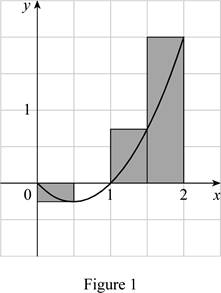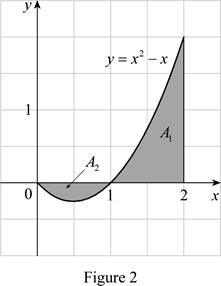
(a)
The Riemann sum with four subintervals for the function at the right endpoints.
(a)
Answer to Problem 2RE
The Riemann sum with four subintervals at the right endpoint is 1.25.
Explanation of Solution
Given information:
The function as
The region lies between
Consider that the Number of rectangles as
The expression to find Riemann sum at the right endpoint
Here, the height of sample at the right endpoint is
Find the width
Here, the upper limit is b, the lower limit is a, and the number of rectangles is n.
Substitute 2 for b, 0 for a, and 4 for n in Equation (2).
Calculate
Substitute 4 for n in equation (1).
Substitute
At
At
At
At
Draw four rectangles at the right endpoints based on the functions as shown in Figure (1).

Substitute 0.5 for
Therefore, Riemann sum with four subintervals at the right endpoint is 1.25.
(b)
The value of the
(b)
Answer to Problem 2RE
The value of the integral is
Explanation of Solution
Given information:
The function as
The region lies between
The expression to find the value of the integral using the definition of a definite integral is shown below:
Substitute 2 for b and 0 for a in Equation (2).
To find the value of
Substitute 0 for a and
Substitute
Substitute
Therefore, the value of the integral using the definition of a definite integral is
(c)
The value of the integral using the fundamental theorem.
(c)
Answer to Problem 2RE
The value of the integral is
Explanation of Solution
Given information:
The function as
The region lies between
The expression to find the value of the integral using the fundamental theorem is shown below:
Therefore, the value of the integral using the fundamental theorem is
(d)
Draw a diagram to explain the geometric meaning of the integral.
(d)
Answer to Problem 2RE
The geometric meaning of the integral is
Explanation of Solution
Given information:
The function as
The region lies between
Draw the diagram based on the functions as in part (a) as shown in Figure (2).

Refer Figure (1).
Upper portion of the diagram is represented as
The expression to find the geometric value of the function from the diagram as shown below:
Therefore, the geometric mean of the integral
Chapter 5 Solutions
Single Variable Calculus: Concepts and Contexts, Enhanced Edition
- Mid-Term Review Find the formula for (f + g)(x). f(x) = x² - 10x + 25 and g(x) = x² - 10x + 24 (f + g) (x) = [ 2 ]x² X + DELL Skip Sarrow_forwardCalculus III May I please have some elaborations on Example 2 part a? Thank you.arrow_forward1. A bicyclist is riding their bike along the Chicago Lakefront Trail. The velocity (in feet per second) of the bicyclist is recorded below. Use (a) Simpson's Rule, and (b) the Trapezoidal Rule to estimate the total distance the bicyclist traveled during the 8-second period. t 0 2 4 6 8 V 10 15 12 10 16 2. Find the midpoint rule approximation for (a) n = 4 +5 x²dx using n subintervals. 1° 2 (b) n = 8 36 32 28 36 32 28 24 24 20 20 16 16 12 8- 4 1 2 3 4 5 6 12 8 4 1 2 3 4 5 6arrow_forward
- = 5 37 A 4 8 0.5 06 9arrow_forwardConsider the following system of equations, Ax=b : x+2y+3z - w = 2 2x4z2w = 3 -x+6y+17z7w = 0 -9x-2y+13z7w = -14 a. Find the solution to the system. Write it as a parametric equation. You can use a computer to do the row reduction. b. What is a geometric description of the solution? Explain how you know. c. Write the solution in vector form? d. What is the solution to the homogeneous system, Ax=0?arrow_forward2. Find a matrix A with the following qualities a. A is 3 x 3. b. The matrix A is not lower triangular and is not upper triangular. c. At least one value in each row is not a 1, 2,-1, -2, or 0 d. A is invertible.arrow_forward
- Find the exact area inside r=2sin(2\theta ) and outside r=\sqrt(3)arrow_forwardA 20 foot ladder rests on level ground; its head (top) is against a vertical wall. The bottom of the ladder begins by being 12 feet from the wall but begins moving away at the rate of 0.1 feet per second. At what rate is the top of the ladder slipping down the wall? You may use a calculator.arrow_forwardExplain the focus and reasons for establishment of 12.4.1(root test) and 12.4.2(ratio test)arrow_forward
 Calculus: Early TranscendentalsCalculusISBN:9781285741550Author:James StewartPublisher:Cengage Learning
Calculus: Early TranscendentalsCalculusISBN:9781285741550Author:James StewartPublisher:Cengage Learning Thomas' Calculus (14th Edition)CalculusISBN:9780134438986Author:Joel R. Hass, Christopher E. Heil, Maurice D. WeirPublisher:PEARSON
Thomas' Calculus (14th Edition)CalculusISBN:9780134438986Author:Joel R. Hass, Christopher E. Heil, Maurice D. WeirPublisher:PEARSON Calculus: Early Transcendentals (3rd Edition)CalculusISBN:9780134763644Author:William L. Briggs, Lyle Cochran, Bernard Gillett, Eric SchulzPublisher:PEARSON
Calculus: Early Transcendentals (3rd Edition)CalculusISBN:9780134763644Author:William L. Briggs, Lyle Cochran, Bernard Gillett, Eric SchulzPublisher:PEARSON Calculus: Early TranscendentalsCalculusISBN:9781319050740Author:Jon Rogawski, Colin Adams, Robert FranzosaPublisher:W. H. Freeman
Calculus: Early TranscendentalsCalculusISBN:9781319050740Author:Jon Rogawski, Colin Adams, Robert FranzosaPublisher:W. H. Freeman
 Calculus: Early Transcendental FunctionsCalculusISBN:9781337552516Author:Ron Larson, Bruce H. EdwardsPublisher:Cengage Learning
Calculus: Early Transcendental FunctionsCalculusISBN:9781337552516Author:Ron Larson, Bruce H. EdwardsPublisher:Cengage Learning





